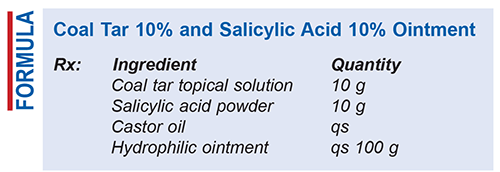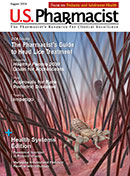US Pharm. 2024;49(8):59-60.

Method of Preparation: Start by calculating and weighing the required quantity of each ingredient for the total amount to be prepared. Let the coal tar topical solution rest at room temperature for a while, until the alcohol has evaporated. Next, triturate the salicylic acid powder in a mortar until it is finely textured; then add a few drops of castor oil to the triturated powder and combine. Incorporate the coal tar solution into the salicylic acid mixture, dispersing it evenly, until it forms a smooth paste. Geometrically, incorporate the hydrophilic ointment into the mixture to achieve the final desired weight, and mix until homogenous. Package the ointment and label the container appropriately.
Use: Coal tar 10% and salicylic acid 10% ointment has been used to treat skin inflammation and other skin-related conditions, such as psoriasis, in general patient populations, including children.
Packaging: Package ointment in a tight, light-resistant container. Store at controlled room temperature.
Labeling: Keep out of reach of children. Use only as directed. For external use only. Store in a cool, dry place. Discard after [time period].1
Stability: The USP default beyond-use date for the solid dosage preparation is up to 180 days when stored at room temperature.2 Note that stability studies may be performed that explore the extension of this beyond-use date.
Quality Control: Weight/volume, pH, specific gravity, active drug assay, color, rheologic properties/pourability, physical observation, and physical stability (discoloration, foreign materials, gas formation, mold growth) are all examples of quality-control assessments.2
Discussion: Coal tar (C14H18O4ClN5) is a medicinal byproduct of the destructive distillation of bituminous coal at 900°C to 1,100°C. It can be further processed through alcohol extraction or fractional distillation. Coal tar promotes the shedding of dead skin cells, slows skin-cell growth, reduces scaling and dryness, and alleviates itching. Coal tar has been used for more than a century to treat skin disorders because of its anti-inflammatory, antipruritic, and keratolytic properties.3
Salicylic acid (C7H6O3, MW 138.12) is a white, crystalline powder with a slight yellow or pink tint and a faint, mint-like odor. It is stable in air, slightly soluble in water, and freely soluble in alcohol. Salicylic acid softens and loosens dry, scaly, or thickened skin, facilitating its removal. Additionally, salicylic acid reduces redness and swelling associated with pimples, reducing the number of pimples and speeding healing.4 Coal tar and salicylic acid work synergistically to treat skin conditions by reducing inflammation, itching, and scaling, promoting the shedding of dead skin cells, and accelerating healing. The oily base of the ointment moisturizes the skin and enhances the delivery of active ingredients.
Castor oil is a pale yellow, viscous liquid with a mild odor. It is soluble in alcohol and historically has been used in soaps, lubricants, and coatings. An FDA-approved food additive, castor oil is used as a release and antisticking agent in candies and as a protective coating for supplements.5
Hydrophilic ointment is a water-removable, oil-in-water emulsion containing methylparaben, propylparaben, sodium lauryl sulfate, propylene glycol, stearyl alcohol, white petrolatum, and purified water. It can incorporate oil solutions and may be replaced with various topical vehicles. Most studies use oil-in-water cream bases, but to make a lotion, preserved purified water may be added slowly while mixing.6,7
REFERENCES
1. U.S. Pharmacopeia/National Formulary [current revision]. Rockville, MD: U.S. Pharmacopeial Convention, Inc; September 2022.
2. Allen LV Jr. Standard operating procedure for performing physical quality assessment of ointments/creams/gels. IJPC. 1998;2:308-309.
3. Coal tar. U.S. Pharmacopeia/National Formulary. Rockville, MD: U.S. Pharmacopeial Convention, Inc; 2024.
4. USP Pharmacists’ Pharmacopeia. 2nd ed. Rockville, MD: U.S. Pharmacopeial Convention, Inc; 2008:90,312,1426,1459.
5. Ogunniyi DS: Castor oil: a vital industrial raw material. Bioresour Technol. 2006;97(9):1086-1091.
6. Reilly WJ Jr. Pharmaceutical necessities. In: Gennaro AR, ed. Remington: The Science and Practice of Pharmacy. 19th ed. Easton, PA: Mack Publishing Co; 1995:1402.
7. Block LH. Medicated applications. In: Gennaro AR, ed. Remington: The Science and Practice of Pharmacy. 19th ed. Easton, PA: Mack Publishing Co; 1995:1586.
The content contained in this article is for informational purposes only. The content is not intended to be a substitute for professional advice. Reliance on any information provided in this article is solely at your own risk.
To comment on this article, contact rdavidson@uspharmacist.com.





